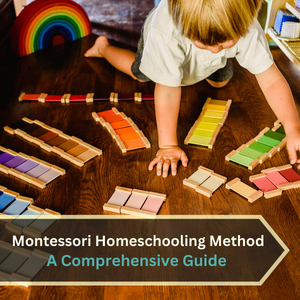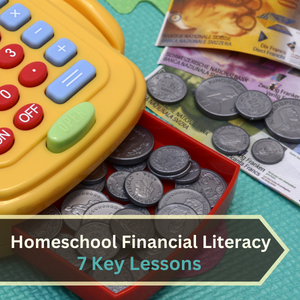Hello, dear readers! Today, we’re diving into the world of the Montessori Homeschooling Method, a unique approach to homeschooling that’s captivating families everywhere. Are you curious about what makes the Montessori homeschooling method stand out? Let’s explore together!
Defining Montessori Homeschooling and Its Core Principles
At the heart of the Montessori Method is a philosophy that respects the child’s natural desire to learn. Montessori homeschooling emphasizes independence, hands-on learning, and a supportive environment tailored to each child’s pace and interests. This method fosters self-discipline and a love for learning, making it a compelling choice for many families.
The History and Philosophy of Maria Montessori

An Italian physician and educator, Dr. Maria Montessori, developed the Montessori Method. Her approach, grounded in scientific observation, revolutionized early childhood education. Montessori observed that children learn best in environments where they can freely interact with educational materials, leading to the creation of the Montessori homeschooling philosophy.
Reasons Why Montessori Homeschooling is Beneficial for Preschoolers
When it comes to preschoolers, the Montessori Method offers numerous advantages:
- Enhanced Focus and Concentration: Montessori homeschooling promotes more extended periods of concentration by allowing children to choose their activities.
- Development of Fine Motor Skills: Using hands-on materials improves physical coordination and fine motor skills.
- Fostering Independence: Preschoolers learn to take responsibility for their learning, an invaluable skill throughout their education.
- Cultivating a Love for Learning: The Montessori homeschooling method encourages curiosity and makes learning a joyous and natural process.
Why Choose Montessori Homeschool for Your Family’s Curriculum?
Aligning with Family Values and Goals
Embracing a Child-Centric Approach
Montessori homeschooling is renowned for its focus on the child as an individual. This approach respects each child’s unique learning pace and interests, aligning with the values of many families who seek a more personalized and compassionate educational method.
Fostering Independence and Responsibility
One of the core tenets of Montessori education is encouraging independence. In a Montessori homeschool setting, children can choose their activities and are guided to manage their learning process. This fosters responsibility and self-discipline, preparing them for future challenges.
Building a Love for Learning
Montessori homeschooling isn’t just about imparting knowledge but sparking curiosity. By allowing children to explore topics that genuinely interest them, Montessori at home nurtures a lifelong love for learning. This intrinsic motivation is key to educational success. It is a great way to introduce learning to preschool children.
Tailored Learning Experiences
Adaptable Curriculum
Unlike traditional schooling, Montessori homeschooling doesn’t follow a one-size-fits-all curriculum. You can tailor your lessons to suit your child’s needs, interests, and learning pace, ensuring a more effective and enjoyable learning experience.
Hands-On Learning
Montessori materials are designed to provide a hands-on learning experience. These tactile materials help concretize abstract concepts, making learning more engaging and effective for toddlers. You can easily incorporate these materials into everyday learning in a homeschool setting.
Integration with Real-Life Skills
Montessori homeschooling seamlessly integrates academic learning with practical life skills. Children engage in real-life activities like cooking, gardening, and crafting, which teach them practical skills while reinforcing theoretical concepts.
Testimonials and Success Stories from Montessori Homeschooling Families
Across the globe, families practicing Montessori homeschooling share inspiring stories of their children’s growth and achievements. These real-life examples often highlight the Montessori homeschooling method’s transformative power, motivating and reassuring families considering this path.
Crafting Your Montessori Homeschool Curriculum: First Steps
Embarking on the Montessori homeschooling journey requires thoughtful planning. It’s not just about academic achievement; it’s about nurturing a well-rounded individual.
Building a Montessori Curriculum Tailored to Your Child’s Needs
Each child is unique, and the beauty of the Montessori homeschooling method lies in its adaptability. Begin by observing your child’s interests and pace, and then tailor your curriculum to fit these observations.
Integrating Montessori Principles with State Educational Standards
While embracing the Montessori homeschooling philosophy, aligning your curriculum with state standards is crucial. This balance ensures your child enjoys the benefits of Montessori while meeting educational requirements.
Resources and Tools for Effective Curriculum Planning
A wealth of resources is available for the Montessori homeschooling family. From online forums to specialized Montessori materials, these tools aid in crafting an engaging and practical curriculum.
Essential Montessori Materials: What You Need and How to Use Them
Materials play a pivotal role in the Montessori homeschooling method. They are educational tools and keys to unlocking a child’s potential.
Montessori materials are designed to stimulate learning through direct, tactile experiences. They help solidify abstract concepts concretely, which is crucial in the early learning stages. Choosing the right materials is essential. For preschoolers, start with simple, inviting items that challenge but don’t frustrate. This fosters a positive learning experience in your Montessori homeschooling environment.
Tips for Creating DIY Montessori Materials at Home
Budget constraints? No problem! Many Montessori materials can be DIY-ed. You can create an effective learning environment at home with creativity and resourcefulness.
Montessori at home on a budget:
Sensory Bins for Exploration and Fine Motor Skills Development:
- Materials Needed: A large, shallow container, various fillers (rice, beans, sand, water, or pasta), and small objects or toys for exploration (like small figurines, buttons, or shells).
- How to Use: Fill the bin with your chosen filler and mix in the miniature objects. Provide tools like scoops, tongs, or spoons for your child to explore and manipulate the contents. This activity enhances sensory processing and fine motor skills and can be themed (like a nature-themed bin with leaves and twigs) to match current learning topics.
Homemade Counting Beads for Math Skills:
- Materials Needed: String or yarn, beads (any type – plastic, wood, pasta), and scissors.
- How to Create: Cut the string into lengths. Children can string a specific number of beads onto each piece, tying knots at both ends to secure them. Create sets of 1-10 beads.
- How to Use: These bead strings can be used for counting, simple addition and subtraction, and understanding number sequences. It’s a hands-on way to visualize numbers and basic math concepts.
DIY Alphabet Sandpaper Letters for Literacy:
- Materials Needed: Sandpaper, cardstock or thick cardboard, scissors, glue, and a marker.
- How to Create: Cut out letter shapes (uppercase and lowercase) from the sandpaper. Trace the letter shapes onto the cardstock or cardboard and cut them out. Glue the sandpaper letters onto the cardstock.
- How to Use: These tactile letters help children learn the alphabet by tracing them with their fingers, linking the physical sensation of each letter with its visual form and sound. This multi-sensory approach is fundamental in Montessori teaching for early literacy skills.
Disadvantages of the Montessori Homeschool Method
Resource Intensity: One of the primary challenges of the Montessori homeschooling method is the need for specific materials and resources. Authentic Montessori materials can be expensive, and creating a learning environment that closely mirrors a Montessori classroom requires significant time, effort, and money. Parents who choose this method must be prepared for this investment, and those with limited resources might find it challenging to implement it fully.
- Demanding Parental Involvement: Montessori homeschooling requires a high degree of parental involvement as educators, planners, and organizers of the learning environment. Parents must understand and be trained in Montessori principles to facilitate this education method effectively. Maintaining the level of involvement required can be pretty challenging for parents who are working, have other children, or have limited time.
- Lack of Structure and Formal Assessment: The Montessori method is less structured than traditional education systems and often lacks formal testing and assessment. While this can be beneficial in fostering creativity and independent learning, some children may thrive better in a more structured environment with clear benchmarks for progress. Additionally, parents may find it challenging to assess their child’s academic progress without the traditional markers provided in conventional schooling systems.
Reflection
To wrap up, the Montessori homeschooling method is more than an educational choice; it’s a journey of discovery for the whole family. It fosters independence, a love for learning, and respect for each child’s unique pace.
Remember, Montessori, homeschooling fosters independence, develops a love for learning, and tailors education to your child’s unique needs. From nurturing well-rounded individuals to providing a hands-on learning experience, the benefits of Montessori homeschooling are vast and deeply impactful.
To all the families embarking on this beautiful journey, remember every child blooms in their own time and way. The Montessori homeschooling method is a beautiful path to facilitate this natural growth.
Visit more amazing reviews at Happy Pages Homeschool.




